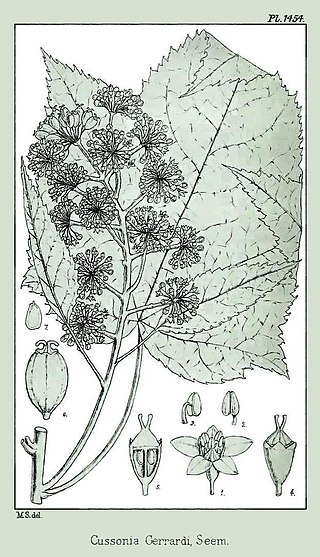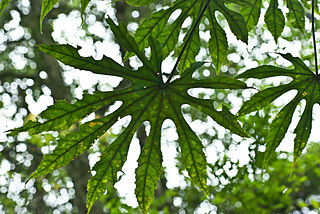
Aralia elata, the Japanese angelica tree, Chinese angelica-tree, or Korean angelica-tree, is a woody plant belonging to the family Araliaceae. It is known as tara-no-ki in Japanese, and dureup-namu (두릅나무) in Korean.

The Araliaceae are a family of flowering plants composed of about 43 genera and around 1500 species consisting of primarily woody plants and some herbaceous plants commonly called the ginseng family. The morphology of Araliaceae varies widely, but it is predominantly distinguishable based on its woody habit, tropical distribution, and the presence of simple umbels.

Aralia, or spikenard, is a genus of the family Araliaceae, consisting of 68 accepted species of deciduous or evergreen trees, shrubs, and rhizomatous herbaceous perennials. The genus is native to Asia and the Americas, with most species occurring in mountain woodlands. Aralia plants vary in size, with some herbaceous species only reaching 50 centimetres (20 in) tall, while some are trees growing to 20 metres (66 ft) tall.

Ginseng is the root of plants in the genus Panax, such as Korean ginseng, South China ginseng, and American ginseng, characterized by the presence of ginsenosides and gintonin. Ginseng is common in the cuisines and medicines of China and Korea.

In chemistry, a glycoside is a molecule in which a sugar is bound to another functional group via a glycosidic bond. Glycosides play numerous important roles in living organisms. Many plants store chemicals in the form of inactive glycosides. These can be activated by enzyme hydrolysis, which causes the sugar part to be broken off, making the chemical available for use. Many such plant glycosides are used as medications. Several species of Heliconius butterfly are capable of incorporating these plant compounds as a form of chemical defense against predators. In animals and humans, poisons are often bound to sugar molecules as part of their elimination from the body.
Saponins, also selectively referred to as triterpene glycosides, are bitter-tasting usually toxic plant-derived organic chemicals that have a foamy quality when agitated in water. They are widely distributed but found particularly in soapwort, a flowering plant, the soapbark tree and soybeans. They are used in soaps, medicines, fire extinguishers, speciously as dietary supplements, for synthesis of steroids, and in carbonated beverages. Saponins are both water and fat soluble, which gives them their useful soap properties. Some examples of these chemicals are glycyrrhizin and quillaia, a bark extract used in beverages.

GastoniaCommerson ex Lamarck is a formerly accepted genus of plants in the ivy and ginseng family, Araliaceae. It had been known as an unnatural group, but was recognized as late as 2010, when its nine species were distributed to four different subgenera of the large genus Polyscias. Because the genus Gastonia is now obsolete, its species are herein referred to by their names in Polyscias.

Aralia spinosa, commonly known as devil's walking stick, is a woody species of plant in the genus Aralia, family Araliaceae, native to eastern North America. The various names refer to the viciously sharp, spiny stems, petioles, and even leaf midribs. It has also been known as Angelica-tree.

Aralia cordata is an upright herbaceous perennial plant growing up to 2 to 3 metres in height, native to Japan, Korea and eastern China. Its common names include spikenard, herbal aralia, udo, Japanese spikenard, and mountain asparagus. It is commonly found on the slopes of wooded embankments. Aralia cordata is a species of Aralia in the family Araliaceae.

Aralia californica, known by the common name elk clover though not actually a clover, is a large herb in the family Araliaceae, the only member of the ginseng family native to California and southwestern Oregon. It is also called California aralia and California spikenard.

Polyscias racemosa, or false 'ohe, is a species of flowering plant in the family Araliaceae. As Munroidendron racemosum, the species was until recently considered to be the only species in the monotypic genus Munroidendron. With the change in classification, Munroidendron is now obsolete. Polyscias racemosa is endemic to the Hawaiian island of Kauai. It is very rare in the wild and some of its original habitat has been replaced by sugar cane plantations. It was thought for some time to be probably extinct, but was rediscovered a few years prior to 1967.

Fatsia japonica, also fatsi, paperplant, false castor oil plant, or Japanese aralia, is a species of flowering plant in the family Araliaceae, native to southern Japan and southern Korea.

Polyscias is a genus of flowering plants in the family Araliaceae. They bear pinnately compound leaves.

Seemannaralia gerrardii, commonly known as the wild-maple or mock carrot tree, is a species of flowering plant in the family Araliaceae. It is the sole member of genus Seemannaralia, and is endemic to South Africa, where it occurs in the Eastern Cape, KwaZulu-Natal, Limpopo and Mpumalanga provinces. It was originally included in genus Cussonia. Seemann- and gerrardii commemorate Berthold Seemann and William Gerrard respectively, while -aralia suggests the family or its type genus, Aralia.

Panax notoginseng is a species of the genus Panax, and it is commonly referred to in English as Chinese ginseng or notoginseng. In Chinese it is called tiánqī, tienchi ginseng, sānqī or sanchi, three-seven root, and mountain plant. P. notoginseng belongs to the same scientific genus as Panax ginseng. In Latin, the word panax means "cure-all", and the family of ginseng plants is one of the best-known herbs.

Ixora coccinea is a species of flowering plant in the family Rubiaceae. It is a common flowering shrub native to Southern India, Bangladesh, and Sri Lanka. It has become one of the most popular flowering shrubs in South Florida gardens and landscapes. It is the national flower of Suriname. Commercially important medicinal plant, used in ayurveda. All parts including flower, leaves and root are taken for various medicinal preparations for skin disease, Diabetes etc

Fatsia polycarpa, the many-fruited aralia, is a species of flowering plant in the family Araliaceae, endemic to Taiwan, where it is threatened by habitat loss. Growing to 4 m (13 ft) tall by 2.5 m (8.2 ft) broad, it is a substantial evergreen shrub with large palmate leaves to 30 cm (12 in). Spherical clusters of cream or white flowers are produced in winter, followed by black fruits in spring.

Plerandra elegantissima, the false aralia, is a species of flowering plant in the family Araliaceae, native to New Caledonia.

Eryngium foetidum is a tropical perennial herb in the family Apiaceae. Common names include culantro, recao, chadon beni, Mexican coriander, bandhaniya, long coriander, Burmese coriander, sawtooth coriander, and ngò gai. It is native to Mexico, the Caribbean, and Central and South America, but is cultivated worldwide, mostly in the tropics as a perennial, but sometimes in temperate climates as an annual.

American ginseng is a herbaceous perennial plant in the ivy family, commonly used as an herb in traditional Chinese medicine. It is native to eastern North America, though it is also cultivated in China. Since the 18th century, American ginseng has been primarily exported to Asia, where it is highly valued for its cooling and sedative medicinal effects. It is considered to represent the cooling yin qualities, while Asian ginseng embodies the warmer aspects of yang.



















